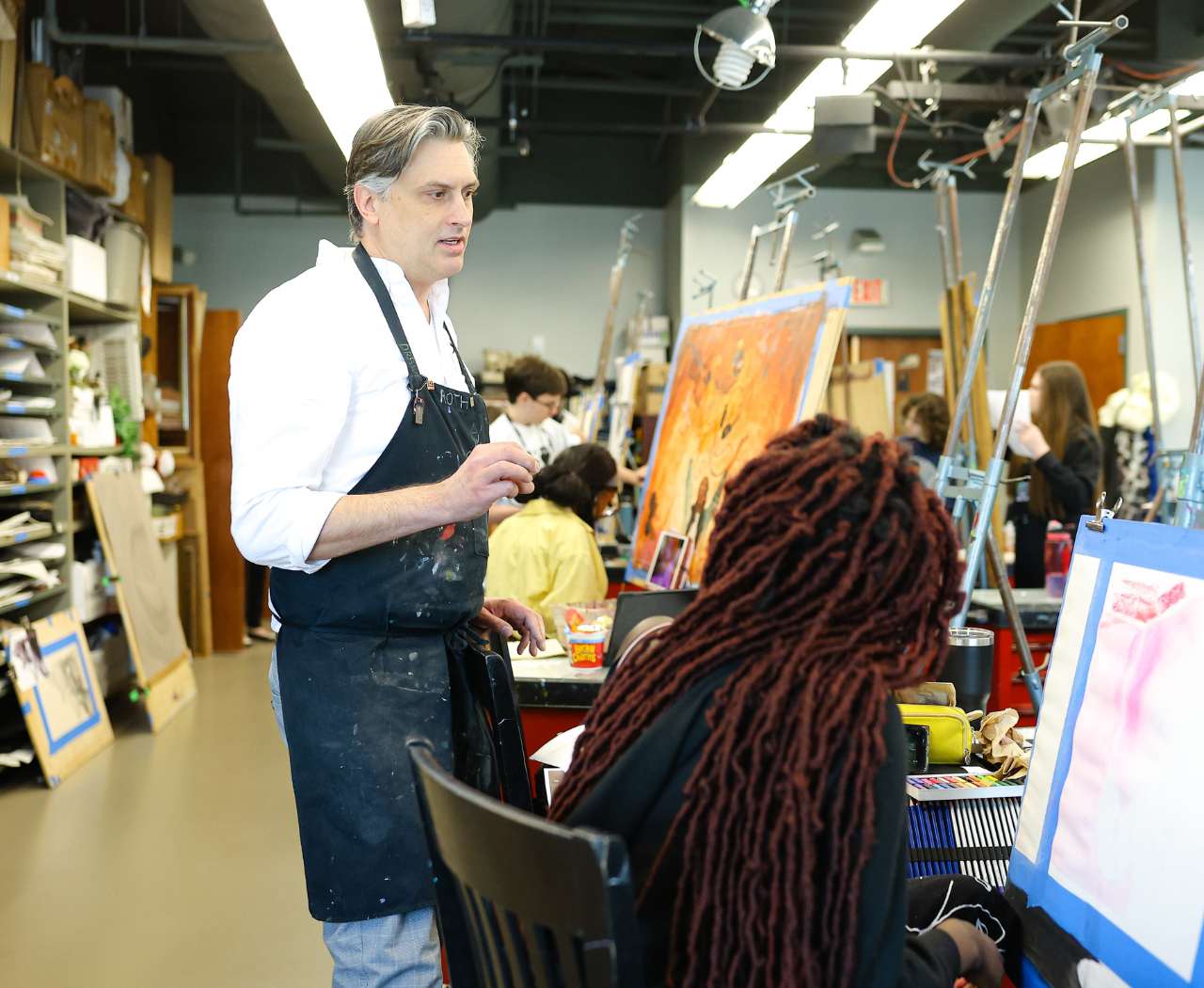The goal of the Visual Arts Program at the Fine Arts Center is to encourage the growth and development of young artists fostered through the guidance of teachers (all of whom are practicing artists). The Visual Arts curriculum requires a high degree of commitment, concentrated effort, extra time, and rigor – establishing a strong foundation in design and technique, on which students can build during a year–long (or multi-year) curriculum that encourages self confidence and development of stylistic vision.
Upon completion of study, students of the Fine Arts Center should be able to display the maturity necessary to accept a critical examination of work and succeed in a Fine or Liberal Arts based program of higher education.
The interview/portfolio review process will help the faculty determine a student’s class placement. We encourage all Visual Arts students to enroll in Art History and to join the FAC chapter of the National Art Honor Society. All students enrolled in their 2nd or 3rd year of Visual Arts MUST enroll in either Art History or AP Studio Art (2D, 3D, or Drawing). All Fine Arts Center seniors, new and returning, must complete a senior project. All students must have their portfolio reviewed to attend the Fine Arts Center, and current students are expected to meet course requirements to return annually.
Students are accepted into the Visual Arts Program, not into specific classes. While we try to place students into the class that they request, the priority is to place students into classes that will strengthen their portfolio and balance our classes (typically 8-12 students). For instance, many first year students will be placed into our full-year 2D/3D Design class or our semester-long Design Topics.
Visual Arts classes in Ceramics, Design, Drawing/Painting/Printmaking, Fiber Arts, Metals, and Photography meet five days per week and are offered between 9:15–11:05 and 1:30–3:20. Generally, first year students attend our morning session, and continuing students attend the afternoon session.
These programs are designed to nurture creativity, develop artistic skills, and foster a deeper appreciation for the arts.
Metals Classes incorporate intensive studio work, individual, group discussions and critiques, as well as lectures and presentations. The objective is for students to develop critical thinking skills and an understanding of the history and context of art and contemporary concerns, as they cultivate their own work. By experiencing a broad range of approaches and ideas, individuals are encouraged to develop an art practice that is relevant to their ideas and sensibility.
The aim is for students to leave the area with an understanding of their own intentions and visual language, strategies for sustaining an artistic practice, critical thinking skills, an understanding of the historical context and contemporary possibilities of metals and jewelry as a media for artistic expression.
Classes are organized to introduce students to the fundamentals of designing and fabricating objects, wall-pieces, or jewelry with sheet metal, wire, glass, and non-metal materials. Course content involves students in four major activities:
DESIGN, which includes a review of the elements and principles of design; renderings to express ideas visually with shape; revisions; models to express ideas visually with form; and study of historical and contemporary metalwork.
LEARNING SAFE AND EFFICIENT USE OF STUDIO FACILITIES, including general safety requirements; demonstration of major equipment such as the acetylene torch, the bench shear, the flexible shaft, the rolling mill, drill press, the hydraulic press, the polishing machine, kilns and hand tools.
DEMONSTRATION OF PROCESSES AND TECHNIQUES, including cutting and piercing with the jeweler’s saw; finishing by filing, sanding, polishing, chasing and repoussé; roller embossing; roller printing; annealing; forming by stretching, folding, and soldering; riveting; and patinas and enameling among others.
CREATION OF ART in a manner that reflects competence and originality in design and technical approach, craftsmanship, and suitability of materials and processes to the ideas and/or functions implied by the object.
DEVELOPING THEMES AND CONTENT within a body of work, and building the best art portfolio possible.
The objective of the Fiber Arts program is to introduce foundational fiber techniques and concepts, focusing on surface design and fabric construction techniques, craftsmanship and presentation skills, and to enable exploration of fiber as a material for artistic expression.
Students will demonstrate an understanding of surface design by learning wet processes such as direct printing techniques like block printing, screen printing and silk painting, along with resist dyeing techniques like, shibori, batik and discharge. During this surface design course, there will be a focus on developing repeating patterns for both digital and hand printing techniques.
Students will also build their understanding of surface design through embellishment with stitching, appliqué and embroidery in addition to various fabric-manipulation techniques.
During more advanced fiber courses, students will demonstrate an understanding of fabric formation and material construction by learning and implementing construction processes such as weaving, tapestry, braiding, basket making, lacemaking, quilting and felting techniques.
Additionally, there will be a focus on building a basic foundation in Fashion Design techniques such as sewing/clothing construction, draping, pattern making, illustration, with an emphasis on Wearable Sculpture.
Students will leave the program with a unified portfolio, a resume, a slideshow lecture on their work and studio processes, and experience in applying to scholarships, job opportunities, gallery exhibitions and student competitions.
Ceramics I will introduce basic forming methods in clay such as pinching, slab building and coiling, as well as various surfacing techniques. An emphasis will be placed upon creating dynamic three-dimensional forms with a coherent surface/form relationship. Students will become familiar with glazing and firing processes as well as studio processes such pugging clay and loading kilns.
Projects will cover both functional pottery and sculptural work. An emphasis will be placed upon discussing the formal and conceptual aspects of their own artwork as well as professional artist examples. Through writing, class discussion, and critiques, students will be led through this process.
Ceramics II will build upon the forming methods introduced in the first class.
Students will experiment with intermediate level building and surfacing techniques such as wheel throwing, and multi-fired surfaces. An emphasis will be placed on students developing themes and creating a cohesive body of work. Working closely with the instructor, students are asked to develop a plan of study for the semester. Students will further develop their critical skills by writing about their work, personal research, and critical discussions in class.
Students enrolled in the photography courses at the Fine Arts Center will study the principles, terminology, techniques, tools, and materials of advanced photography. The successful student will produce quality photographic prints using digital and/or analog processes.
This class, while technical in nature is structured to support the student’s ability to begin building in-depth conceptual works through long – term exploration of concepts.
By the end of the semester each student should be able to identify potential directions of photography within career fields, differentiate between fine art and commercial imagery and continue developing a creative eye for seeing images and portfolio of work, through the practice of photographic exercises, critiques of their work, and the study of basic photographic tools and language.

The class incorporates intensive studio work, individual, group discussions and critiques, as well as slide lectures and presentations. The objective is for students to develop critical thinking skills and an understanding of the history and context of art and contemporary concerns, as they cultivate their own work. By experiencing a broad range of approaches and ideas, individuals are encouraged to develop an art practice that is relevant to their ideas and sensibility. The aim is for students to leave the area with an understanding of their own intentions and visual language, some strategies for sustaining an artistic practice, critical thinking skills, an understanding of the historical context and contemporary possibilities of drawing, painting and printmaking.
Within the drawing, painting, and printmaking area there are three separate yet integrated parts.
Drawing: introduces students to the relationships between seeing and thinking and making, which are central to artistic practice. Through an exploration of many drawing modes and materials, students investigate ways of seeing, visual problem solving, the construction of space and how meaning is experienced through visual language.
Painting: introduces students to the basic techniques and practices of painting, as well as ways of seeing and translating visual experience and constructing meaning through painting.
Printmaking: introduces students to a range of traditional techniques and provides a wide exposure to contemporary practices in print media. The students will work in one of the major printmaking processes: relief, intaglio, dry point, or monotype. Experimentation with technique, process and format is encouraged along with interdisciplinary exploration in other media areas.
This course is designed to give students an opportunity to better understand the elements and principles of art through instruction, production, exploration and the use of a variety of art media. Students will create a series of exercises and completed works demonstrating artistic growth throughout the year while using the elements and principles of design in two-dimensional and three-dimensional work. Students will incorporate the study of artists, sketchbook assignments, and a variety of tools and techniques as they explore 2D and 3D design. Students will prepare a portfolio that reflects originality, quality, growth, and expressive qualities.
